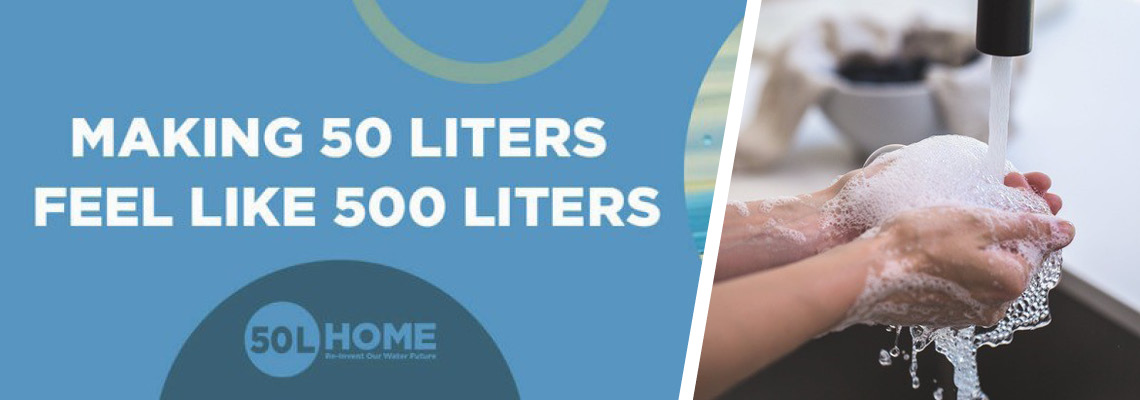A global movement called the 50L Home Coalition wants to re-invent the future of water and change the narrative on domestic consumption. We look into its first whitepaper focusing on bringing water reuse into the home.
Making 50 litres feel like 500
Could you live on 50 litres of water per day?
A new coalition backed by major multinationals is aiming to rewrite the narrative on domestic water consumption to help make 50 litres feel like 500.
Called the 50L Home Coalition, the group is proposing the adoption of new water reuse and efficiency technologies in the home to reduce the water footprint of individuals.
Founded in October 2020, the coalition includes the World Economic Forum, Kohler, Procter & Gamble (P&G), SUEZ, ENGIE, Arcadis and Electrolux.
A new whitepaper, called ‘A Circular Water Future: Whitepaper on Water Reuse’, looks at how urban environments can integrate water reuse and transform existing water systems.
Shailesh G. Jejurikar, the CEO of 50L Home Coalition, said: "We want to enable the ideation and creation of irresistible innovations to transform urban water into zero carbon, safe, and sustainable systems.”
How much water do we need?
The World Health Organisation (WHO) says that the average person only needs between 50 and 100 litres per person per day (lppd) to meet the most basic needs.
The current average water use per day in cities such as Los Angeles and Denver in the US is 428 and 538 litres respectively, considered high.
Compare that to Mexico City and Buenos Aires, and its average daily consumption of 336 and 312 litres respectively.
“WHO says that the average person only needs between 50 and 100 litres per person per day.”
In Europe, the results vary with England's average rate being 150 lppd, in Spain 265 lppd, the Netherlands 218 lppd and France 164 lppd.
While Europe's average water consumption is less than that of the US, each country uses significantly more than the 50 lppd that the 50L Home Coalition wants to achieve.
In Brazil, São Paulo’s water supply came within 20 days of being unable to supply water to its 21.7 million population in 2015.
Reducing water demand in Cape Town
There is a growing list of cities under threat of a potential ‘Day Zero’ scenario as experienced by Cape Town, South Africa. Chennai in India, saw its four reservoirs run dry back in 2019 despite the city being prone to flooding.
Back in 2018, Cape Town in South Africa experienced a 'day-zero' event caused by three seasons of consecutive droughts.
With a population of four million, each household's water usage was limited to 50 lppd. The campaign resulted in a 60 per cent reduction in water consumption from previous levels of usage.
The whitepaper referred to the Cape Town situation as an example of how household water per capita consumption can be reduced dramatically, providing its urgency is clearly articulated by local governments and water municipalities.
Water reuse starts at home
Water reuse is not a new discovery and is currently used in millions of households across the world, ranging from simple homemade solutions to new treatment technologies.
Many new technologies exist that can be retrofitted to old and new homes to expand the reuse capabilities. However, many new technologies are not 'plug and play' and most people are not aware of their existence. As a result, most new housing developers do not offer the options to install water reuse technologies.
The 50L Home Coalition is aware of these barriers but added that reuse models can be exploited across multiple scales, from household, neighbourhood, city and regional.
“Many new technologies are not ‘plug and play’ and most people are not aware of their existence.”
At a household, individual level, for example, this may take the form of recycling showers, greenwater recycling and rooftop rainwater harvesting. At a neighbourhood level, stormwater harvesting, installing water monitoring technologies and building water sustainable housing collectively helps.
While at a city and regional scale, direct potable and non-direct potable reuse can be implemented.
“Water reuse solutions have been explored and tested for over a decade but have not been widely adopted,” added Jejurikar. “Our Coalition’s first publication focuses on exploring new ideas and opportunities to integrate water reuse in our homes and cities.
“It articulates the emerging potential of residential water reuse solutions globally and identifies the barriers and enablers to its adoption."
Related content
- Cape Town’s ‘Day Zero’ – what can we learn?
- Rotterdam, resilience and re-design: breakouts highlights
- Point of Use Tech Dive







